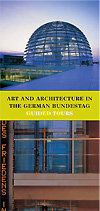Navigationspfad: Homepage > Art and History > Art > Artists
Anselm Kiefer
born in the town of Donaueschingen in 1945, lives and works in Barjac, France.
In Only with wind with time and with sound, a largeformat painting in one of the reception rooms in the Reichstag Building, Kiefer addresses the historical roots of humanity. The picture looks like some archaeological site. In the centre is a huge tower of mud bricks, reminiscent of a Mesopotamian ziggurat. The tower has disintegrated at the sides, where it is barely distinguishable from the ground around it. The monochrome tones of the painting and its crusty surface, with some areas seemingly burnt, almost suggest that it was created from the same material as the tower.
The image is poised between reality and an illusion of reality, its archaeological character intensified by ceramic shards and pieces of paper with writing on embedded in the painted surface. The title, taken from a poem by the Austrian writer Ingeborg Bachmann, is inscribed in the paint at the upper edge. Bachmann’s poem, written in 1957, is titled Exile and describes the condition of an exiled German who has no spiritual home outside his native tongue: ‘I am a dead wanderer / no longer registered anywhere ... long since done with / and provided with nothing / Only with wind with time and with sound.’
The immaterial nature of wind, time and sound is contrasted in Kiefer’s painting with the seemingly solid tower, which symbolises worldly might and, like the tower of Babel, the human presumption that seeks to appropriate divine power by constructing boundless utopias. By inscribing the words ‘wind’, ‘time’ and ‘sound’ in the remains of a tower that appears to have decayed over a period of many centuries, the artist indicates that things we may consider permanent are, in the long term, just as evanescent as inherently fleeting phenomena. By extension, human life on earth may be described as a state of exile, our utopian visions resembling nothing so much as a breath of wind, mutable and insubstantial.
Kiefer’s period as a student of Joseph Beuys at the Düsseldorf Art Academy had a crucial impact on him, focusing his attention on the historical dimension of all human existence. Incorporating fragments of real objects in his paintings and installations, Kiefer addresses both historical and mythological themes.
By representing a ziggurat-type pyramidal structure in his painting in the Reichstag Building, he draws attention to the specific geographical origins of biblical tales. He uses the image of a real or imaginary archaeological site to induce viewers not only to recognise the transience of their actions and desires, but also to welcome the transitory nature of their existence.


